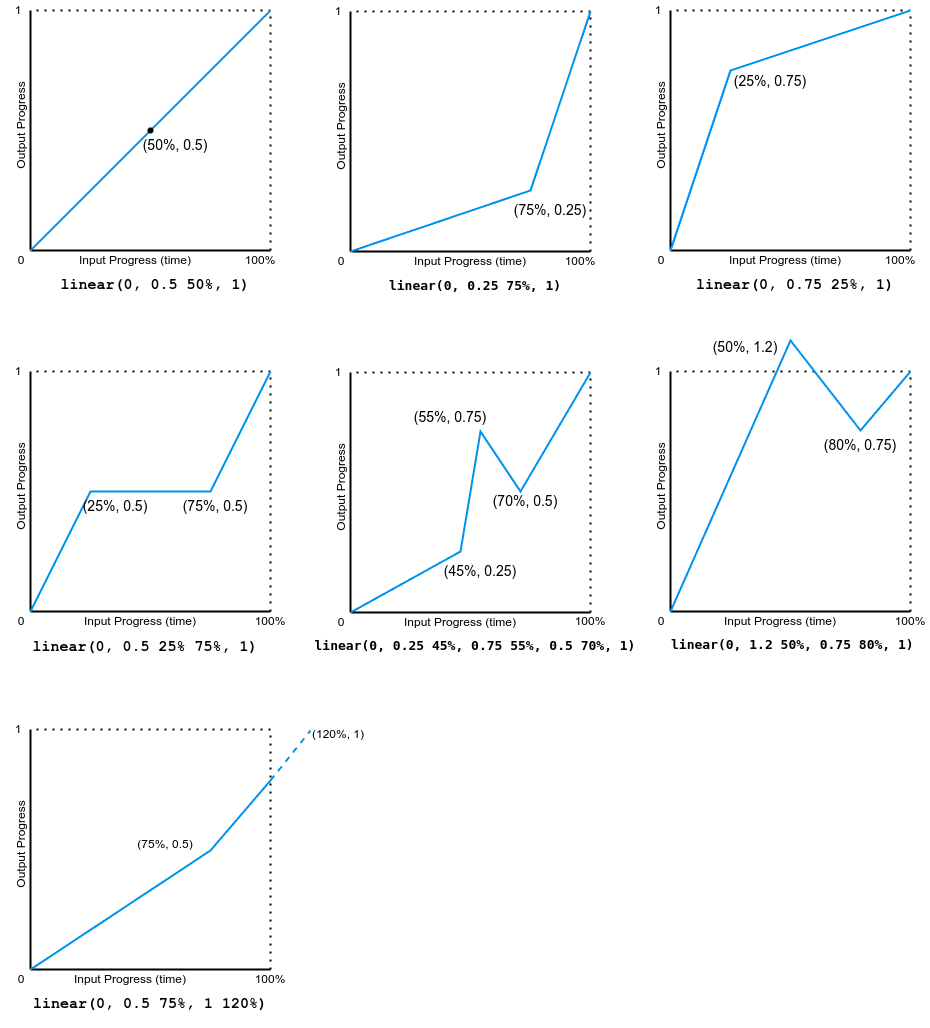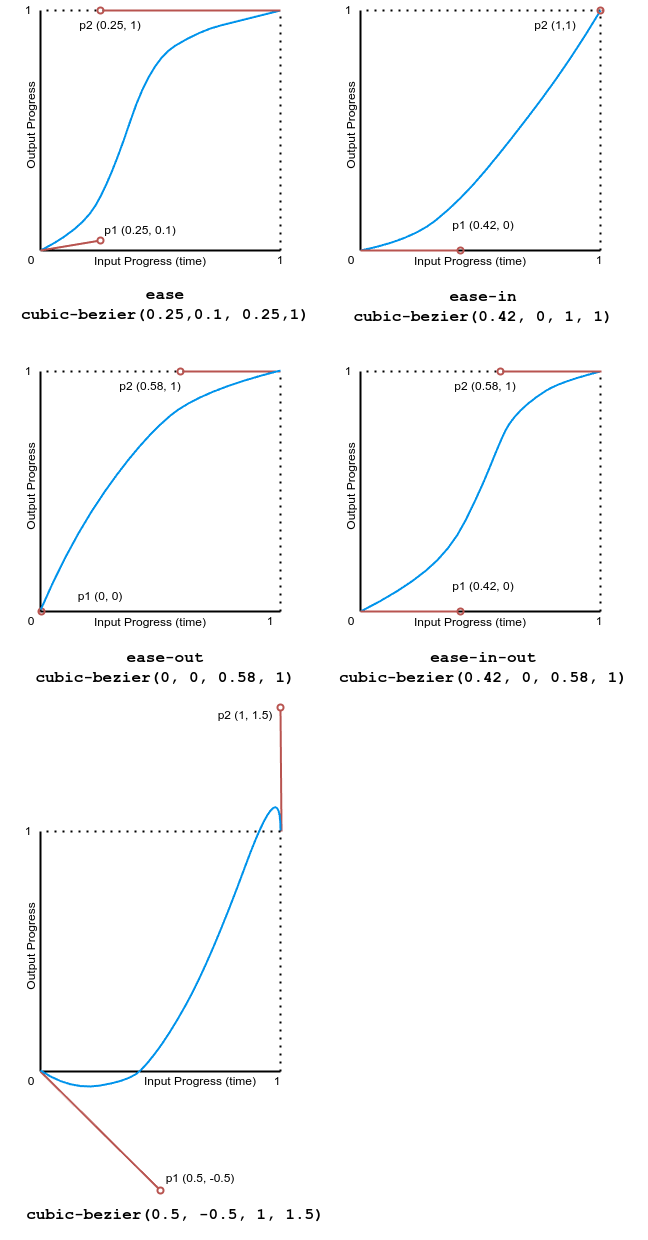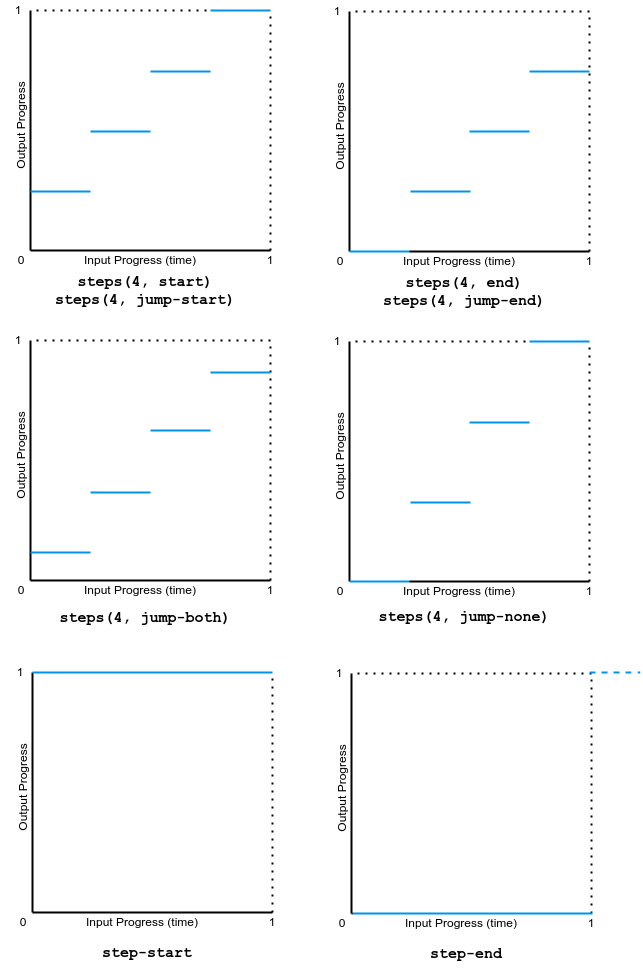animation-timing-function
Baseline
Widely available
This feature is well established and works across many devices and browser versions. It’s been available across browsers since September 2015.
Die animation-timing-function CSS Eigenschaft legt fest, wie eine Animation während der Dauer jedes Zyklus fortschreitet.
Es ist oft praktisch, die Kurzschreibweise animation zu verwenden, um alle Animationseigenschaften auf einmal festzulegen.
Probieren Sie es aus
animation-timing-function: linear;
animation-timing-function: ease-in-out;
animation-timing-function: steps(5, end);
animation-timing-function: cubic-bezier(0.1, -0.6, 0.2, 0);
<section class="flex-column" id="default-example">
<div class="animating" id="example-element"></div>
<button id="play-pause">Play</button>
</section>
#example-element {
animation-duration: 3s;
animation-iteration-count: infinite;
animation-name: slide;
animation-play-state: paused;
background-color: #1766aa;
border-radius: 50%;
border: 5px solid #333333;
color: white;
height: 150px;
margin: auto;
margin-left: 0;
width: 150px;
}
#example-element.running {
animation-play-state: running;
}
#play-pause {
font-size: 2rem;
}
@keyframes slide {
from {
background-color: orange;
color: black;
margin-left: 0;
}
to {
background-color: orange;
color: black;
margin-left: 80%;
}
}
const el = document.getElementById("example-element");
const button = document.getElementById("play-pause");
button.addEventListener("click", () => {
if (el.classList.contains("running")) {
el.classList.remove("running");
button.textContent = "Play";
} else {
el.classList.add("running");
button.textContent = "Pause";
}
});
Syntax
/* Keyword values */
animation-timing-function: ease;
animation-timing-function: ease-in;
animation-timing-function: ease-out;
animation-timing-function: ease-in-out;
animation-timing-function: linear;
animation-timing-function: step-start;
animation-timing-function: step-end;
/* cubic-bezier() function values */
animation-timing-function: cubic-bezier(0.42, 0, 1, 1); /* ease-in */
animation-timing-function: cubic-bezier(0, 0, 0.58, 1); /* ease-out */
animation-timing-function: cubic-bezier(0.42, 0, 0.58, 1); /* ease-in-out */
/* linear() function values */
animation-timing-function: linear(0, 0.25, 1);
animation-timing-function: linear(0 0%, 0.25 50%, 1 100%);
animation-timing-function: linear(0, 0.25 50% 75%, 1);
animation-timing-function: linear(0, 0.25 50%, 0.25 75%, 1);
/* steps() function values */
animation-timing-function: steps(4, jump-start);
animation-timing-function: steps(10, jump-end);
animation-timing-function: steps(20, jump-none);
animation-timing-function: steps(5, jump-both);
animation-timing-function: steps(6, start);
animation-timing-function: steps(8, end);
/* Multiple animations */
animation-timing-function: ease, step-start, cubic-bezier(0.1, 0.7, 1, 0.1);
/* Global values */
animation-timing-function: inherit;
animation-timing-function: initial;
animation-timing-function: revert;
animation-timing-function: revert-layer;
animation-timing-function: unset;
Werte
<easing-function>-
Die Easing-Funktion, die einer bestimmten Animation entspricht, wie durch
animation-namebestimmt.Die nicht von Schritten abgeleiteten Schlüsselwortwerte (
ease,linear,ease-in-out, etc.) repräsentieren jeweils kubische Bézier-Kurven mit festgelegten Vier-Punkt-Werten, während dercubic-bezier()Funktionswert die Angabe nicht vordefinierter Werte ermöglicht. Diesteps()Easing-Funktion teilt die Eingabezeit in eine festgelegte Anzahl gleichlanger Intervalle. Ihre Parameter umfassen eine Anzahl von Schritten und eine Schrittposition.linear-
Entspricht
cubic-bezier(0.0, 0.0, 1.0, 1.0), animiert mit gleichmäßiger Geschwindigkeit. ease-
Entspricht
cubic-bezier(0.25, 0.1, 0.25, 1.0), der Standardwert, beschleunigt in der Mitte der Animation und verlangsamt sich am Ende wieder. ease-in-
Entspricht
cubic-bezier(0.42, 0, 1.0, 1.0), beginnt langsam, wobei die Geschwindigkeit des Übergangs der animierenden Eigenschaft zunimmt, bis vollständig abgeschlossen. ease-out-
Entspricht
cubic-bezier(0, 0, 0.58, 1.0), beginnt schnell und verlangsamt sich, während die Animation fortschreitet. ease-in-out-
Entspricht
cubic-bezier(0.42, 0, 0.58, 1.0), wobei die animierenden Eigenschaften langsam übergehen, beschleunigen und dann wieder verlangsamen. cubic-bezier(<number [0,1]> , <number> , <number [0,1]> , <number>)-
Eine vom Autor definierte kubische Bézier-Kurve, bei der der erste und dritte Wert im Bereich von 0 bis 1 liegen müssen.
linear(<number> <percentage>{1,2}, …)-
Die Funktion interpoliert linear zwischen den angegebenen Easing-Stoppunkten. Ein Stoppunkt ist ein Paar aus einem Ausgabefortschritt und einem Eingabeprozentsatz. Der Eingabeprozentsatz ist optional und wird abgeleitet, wenn nicht angegeben. Wenn kein Eingabeprozentsatz angegeben wird, werden die ersten und letzten Stoppunkte auf
0%und100%gesetzt und die Stoppunkte in der Mitte erhalten Prozentsätze, die durch lineare Interpolation zwischen den nächstgelegenen vorherigen und nächsten Punkten, die einen Prozentsatzwert haben, abgeleitet werden. steps(<integer>, <step-position>)-
Zeigt eine Animationsiteration entlang n Stopps entlang des Übergangs an, wobei jeder Stopp für gleich lange Zeiten angezeigt wird. Zum Beispiel, wenn n 5 ist, gibt es 5 Schritte. Ob die Animation vorübergehend bei 0%, 20%, 40%, 60% und 80%, bei 20%, 40%, 60%, 80% und 100% hält, oder 5 Stopps zwischen den 0% und 100% der Animation macht, oder 5 Stopps inklusive der 0%- und 100%-Markierungen (bei 0%, 25%, 50%, 75% und 100%) einlegt, hängt davon ab, welche der folgenden Schrittpositionen verwendet wird:
jump-start-
Bezeichnet eine linksseitig kontinuierliche Funktion, sodass der erste Sprung bei Beginn der Animation erfolgt.
jump-end-
Bezeichnet eine rechtseitig kontinuierliche Funktion, sodass der letzte Sprung am Ende der Animation erfolgt. Dies ist der Standard.
jump-none-
Es gibt keinen Sprung an beiden Enden, was während der Interpolation effektiv einen Schritt entfernt. Stattdessen hält es sowohl bei der 0%-Marke als auch bei der 100%-Marke, jeweils für 1/n der Dauer.
jump-both-
Beinhaltet Pausen sowohl bei der 0%- als auch der 100%-Marke, was effektiv einen Schritt während der Animationsiteration hinzufügt.
start-
Gleich wie
jump-start. end-
Gleich wie
jump-end.
step-start-
Entspricht
steps(1, jump-start) step-end-
Entspricht
steps(1, jump-end)
Hinweis:
Wenn Sie mehrere durch Kommas getrennte Werte für eine animation-*-Eigenschaft angeben, werden sie in der Reihenfolge auf die Animationen angewendet, in der die animation-names erscheinen. Für Situationen, in denen die Anzahl der Animationen und animation-*-Eigenschaftswerte nicht übereinstimmen, siehe Festlegen mehrerer Animationseigenschaftswerte.
Hinweis:
animation-timing-function hat die gleiche Wirkung bei der Erstellung von CSS scroll-driven animations wie bei regulären zeitbasierten Animationen.
Beschreibung
Easing-Funktionen können auf individuellen Keyframes in einer @keyframes Regel angegeben werden. Wenn auf einem Keyframe keine animation-timing-function angegeben ist, wird der entsprechende Wert der animation-timing-function des Elements verwendet, auf das die Animation angewendet wird.
Innerhalb eines Keyframes ist animation-timing-function ein at-rule-spezifischer Deskriptor, nicht die Eigenschaft gleichen Namens. Das Timing wird nicht animiert. Vielmehr wird eine Easing-Funktion eines Keyframes auf Basis der Eigenschaft von Keyframe zu Keyframe angewendet, auf der sie angegeben ist, bis zum nächsten Keyframe, der diese Eigenschaft angibt, oder bis zum Ende der Animation, wenn kein nachfolgender Keyframe diese Eigenschaft angibt. Somit wird eine auf dem 100% oder to Keyframe angegebene animation-timing-function niemals verwendet.
Formale Definition
| Anfangswert | ease |
|---|---|
| Anwendbar auf | alle Elemente, ::before und ::after Pseudoelemente |
| Vererbt | Nein |
| Berechneter Wert | wie angegeben |
| Animationstyp | Not animatable |
Formale Syntax
animation-timing-function =
<easing-function>#
<easing-function> =
<linear-easing-function> |
<cubic-bezier-easing-function> |
<step-easing-function>
<linear-easing-function> =
linear |
<linear()>
<cubic-bezier-easing-function> =
ease |
ease-in |
ease-out |
ease-in-out |
<cubic-bezier()>
<step-easing-function> =
step-start |
step-end |
<steps()>
<linear()> =
linear( [ <number> && <percentage>{0,2} ]# )
<cubic-bezier()> =
cubic-bezier( [ <number [0,1]> , <number> ]#{2} )
<steps()> =
steps( <integer> , <step-position>? )
<integer> =
<number-token>
<step-position> =
jump-start |
jump-end |
jump-none |
jump-both |
start |
end
Beispiele
Alle Beispiele in diesem Abschnitt animieren die width- und background-color-Eigenschaften mehrerer <div> Elemente mit unterschiedlichen animation-timing-function Werten. Die Breite wird von 0 auf 100% animiert, und die Hintergrundfarbe wird von Lime auf Magenta animiert.
Beispiele für lineare Funktionen
Das Beispiel zeigt die Effekte verschiedener linear() Easing-Funktionswerte.
Das folgende Bild zeigt Graphen aller linear() Funktionswerte, die in diesem Beispiel verwendet werden. Eingabefortschritt (Zeit) wird auf der x-Achse und Ausgabefortschritt auf der y-Achse dargestellt. Entsprechend der Syntax reicht der Eingabefortschritt von 0 bis 100%, und der Ausgabefortschritt reicht von 0 bis 1.

Beachten Sie, dass der Ausgabewert vorwärts oder rückwärts gehen kann.
Cubic-Bézier Beispiele
Das Beispiel zeigt die Effekte verschiedener Bézier-Kurven-Easing-Funktionen.
Das folgende Bild zeigt Graphen aller kubischen Bézier-Funktionswerte, die in diesem Beispiel verwendet werden. Der Eingabefortschritt (Zeit) reicht von 0 bis 1 und der Ausgabefortschritt reicht von 0 bis 1.

Schrittbeispiele
Dieses Beispiel zeigt die Effekte mehrerer Schritt-Easing-Funktionswerte.
Das folgende Bild zeigt Graphen aller step() Funktionswerte, die in diesem Beispiel verwendet werden. Der Eingabefortschritt (Zeit) und der Ausgabefortschritt reichen von 0 bis 1.

Spezifikationen
| Specification |
|---|
| CSS Animations Level 1 # animation-timing-function |
Browser-Kompatibilität
Siehe auch
- Verwendung von CSS-Animationen
<easing-function>- Modul CSS easing functions
- JavaScript
AnimationEventAPI - Werkzeug zur Erzeugung kubischer Bézier-Kurven
- Andere verwandte Animationseigenschaften:
animation,animation-composition,animation-delay,animation-direction,animation-duration,animation-fill-mode,animation-iteration-count,animation-name,animation-play-state,animation-timeline